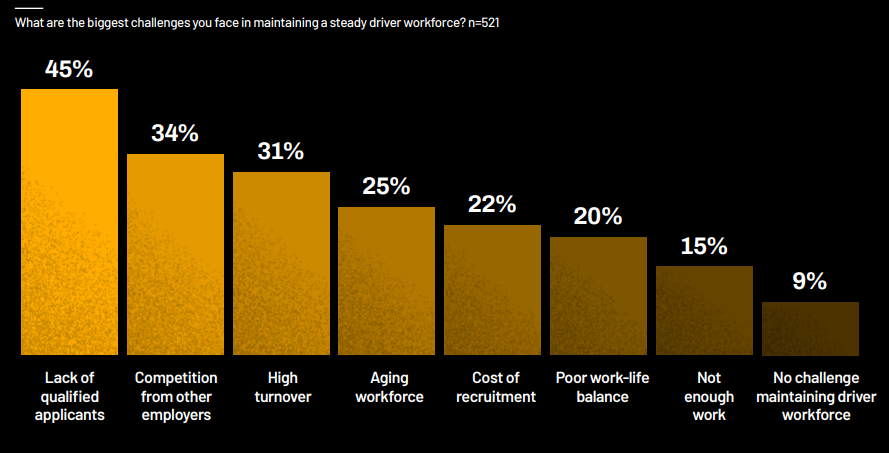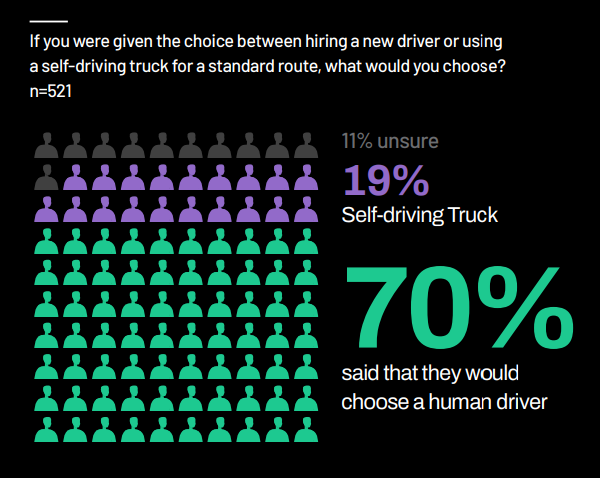The logistics industry is acutely connected to many aspects of the business world. The ability to not only move products from one place to another but also to organize and streamline operations for everyone involved is key to a smooth and efficient supply chain.
If you’re running a logistics business, you need to understand how the industry operates — and there’s no better way to do that than with a bevy of helpful statistics and trends that will inform you on the direction of the industry.
In this guide, you’ll learn about the logistics industry as a whole, how its costs impact businesses around the world, the importance of taking cybersecurity seriously, and how technology is impacting it all.
Logistics Maintenance Statistics
One of the most important aspects of running a logistics business is keeping your fleet well-maintained. In fact, “vehicle upkeep” has been the highest priority for logistics companies across 2025, according to our surveys.
At the same time, financial pressures remain a top concern, and the two concepts — maintenance and cost management — are in conversation with each other. Here’s what fleet professionals had to say in a handful of Tech.co surveys between April and August 2025.
- Vehicle upkeep has consistently been the highest priority for logistics companies across 2025, with about 20% citing it as their company’s top priority across four surveys between April and August 2025.
- “Preventative maintenance (e.g., oil changes, tire rotations)” was the aspect of vehicle upkeep that the most pros were focused on across 2025, with 70% picking it in August 2025, compared with just 51% who selected the second most popular option, “Upgrading or replacing aging components.”
- 16% of logistics professionals said “managing financial pressure” was their top priority in August 2025 — the second highest percentage, after vehicle upkeep at 19%.
- Of those who said vehicle upkeep was their company’s main strategic priority, 23% said rising diesel prices were their biggest issue.
Tariffs and Demand for Logistics Statistics
Demand is the fundamental driver of all activity across the logistics sector, and it is a crucial indicator of its overall health. Fortunately, as the ecommerce boom and consumers’ desires for efficient, timely delivery drive the industry forward, business is strong for the majority of logistics companies.
However, since February, Trump’s administration has been ramping up existing tariffs as well as adding new ones, which can create fluctuations in future freight demand. So, what impacts are we seeing today?
Here are some stats to help you gain a deeper understanding of the situation.
- Tariffs impacted more and more businesses as we moved through 2025. The number of respondents who answered “no” to the question “Have Trump’s tariffs caused a change to your company’s operations?” fell from 23% in April to 22% in June, and then to 18% in August 2025.
- Companies couldn’t agree whether tariffs would reduce freight demand. In August 2025, 38% said they were preparing for lowered freight demand as a result of tariff uncertainty, while 34% said they were not.
- In fact, tariff uncertainty is increasing. Just 21% said “I’m not sure” in April 2025 when asked if they or their company were preparing for reduced freight demand as a result of tariff uncertainty. This rose to 25% in June, then 28% in August.
- The majority (63%) of logistics professionals report an increase in demand over the past year.
- 85% of logistics businesses are operating at near full capacity.
- 43% of logistics businesses say that meeting the demand for reliable deliveries causes them the most pressure.
Hiring and Retaining in Logistics Statistics
Maintaining a steady workforce is key to helping logistics businesses keep up with growing demand. However, while the situation has somewhat stabilized since its peak in 2021, worker shortages continue to plague the logistics sector in 2026. The challenges continue after the onboarding process, too, with high staff turnover rates persisting across many sectors in the industry.
We’ve rounded up some key stats about the hiring and retention landscape in the logistics industry below to help you understand what issues businesses are currently facing.
- Workforce shortages constituted the biggest issue hitting logistics businesses across 2025 — it took the top spot in four out of five surveys, with a second place to “government regulations” in May 2025 marking the only exception.
- “Increasing driver compensation and benefits” is the top strategy logistics companies focused on to improve staffing in August 2025, with 55% of survey respondents picking this answer.
- “Enhancing recruitment efforts” is the second most common strategy logistics companies focused on to improve staffing in August 2025, with 52% of survey respondents.
- Almost half (45%) of logistics businesses say a lack of qualified applicants is the biggest challenge in maintaining a steady driver workforce.
- 69% of respondents say that driver shortages have had an impact on their ability to meet freight demand.
- 31% of logistics managers cite high employee turnover as the number one personnel roadblock they are facing.

Struggling to keep hold of your strongest performers? Learn how to retain your fleet in our comprehensive guide.
Driver shortages won't be going away overnight
The hiring issue is one that is unlikely to go away anytime soon. But, as our research has found, there is help at hand. Technology can provide solutions, and the industry is taking a proactive approach here.

Technology Impacting Logistics Statistics
In 2026, technology will have an impact on every business, not just logistics. Still, between newly digitized systems and AI fleet optimization, the industry is soon to be unrecognizable from just a few short years ago.
Subsequently, understanding where you stand in terms of evolving tech in the industry is more important than ever, which is why we’ve collected some helpful statistics about how technology is transforming logistics.
- Faith in technology is high, with 78% of surveyed logistics companies saying they place either very high or moderate trust in technology to support core logistics operations.
- Fleets with 21-50 vehicles are the most likely size of fleet to consider recruitment software adoption, with 20% considering it and 33% having already started using it (although 47% have not).
- Of those who said “adopting new technology” was their top priority in August, the most popular types of tech were route optimization software (49%) and electronic logging devices (46%).
- In addition, vehicle maintenance systems were a consistently popular response across Tech.co’s 2025 surveys to date for those who made “adopting new technology” their top priority.
- 25% of logistics business owners view technology as a stepping stone toward broader industry transformation.
The industry is relying heavily on tech solutions
The shift to automation and technology is no longer speculative — it is underway and accelerating. Freight businesses are deploying tools that enhance efficiency and reduce workforce strain, empowering employees rather than replacing them.

Driverless Fleet Statistics
One of the biggest technological trends taking place in the logistics industry is the rise of self-driving vehicles. While the hype around the technology may be bigger than its current impact, autonomous trucks are steadily moving from the testing to the deployment phase in specific sectors.
We’ve collected some statistics about the current state of self-driving vehicles, as well as businesses’ opinions on them, to help you understand how the technology is likely to shape the industry going forward.
- 70% of logistics professionals would choose hiring a new, human driver over using a self-driving truck. (Just 19% would opt for the self-driving vehicle.)
- A plurality of logistics professionals expect widespread use of self-driving trucks on public roads by the 2030s: 31% of them picked the 2030s, more than any other decade.
- 63% of logistics businesses are already using technology to reduce reliance on drivers.
- 76% of logistics professionals say that there are some situations where a fully self-driving truck is a good solution.
- Managing routes off public roads and during low-traffic hours are the most popular ways businesses would opt to use self-driving vehicles.

Logistics Statistics: Going Green
Climate-conscious initiatives and “going green” campaigns are among the priorities for logistics and transportation companies. However, they are far from a top concern, according to our data. Here’s what matters most to the sector when it comes to bringing sustainability to logistics.
- Sustainability initiatives are consistently the top priority for the lowest amount of logistics companies across five months of surveys between April (when 7% picked them) and August 2025 (9%).
- The top sustainability initiative in 2025 was “reducing idling time,” with sustained attention across the year, including 54% of logistics companies giving it high attention in August 2025.
- The second biggest sustainability initiative in 2025 was “optimizing routes for fuel efficiency,” with 50% giving it high attention in August 2025.
Logistics Regulation Statistics
The new English proficiency requirements for truckers in the US have been making headlines this year, but they’re far from the only regulation that commercial fleets will be impacted by in the near future. California’s Advanced Clean Fleets rule has issued stricter zero-emissions vehicle requirements for the state, for example.
We’ve collected some valuable statistics below to show how this industry is thinking about regulation, and which rules concern it the most.
- 11% of logistics companies made “Adapting to regulations” their top priority for the current business quarter, according to professionals we polled in August 2025. That’s up from 7% in April 2025.
- Of the companies that prioritized adapting to regulations in August 2025, most of them (59%) picked “Safety and compliance requirements” as their top concern.
- The second biggest issue for this group was “Environmental regulations (e.g. emissions standards),” with 38% saying this was the top concern in August.
We’ve Spoken to Logistics Managers Directly
There’s no denying it — the logistics industry is in a period of unprecedented transformation. As demand continues to climb steadily, and logistics businesses streamline their operations with advancing technology, the supply chain will only continue evolving in the years to come.
Whether you’re a small business owner or an enterprise-level executive, understanding the trajectory of your industry can go a long way towards ensuring success in the long run.
The Tech.co team has spoken with 521 logistics professionals, gaining valuable insights about the trends that are steering the direction of the industry.
